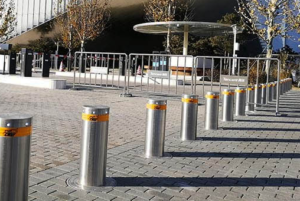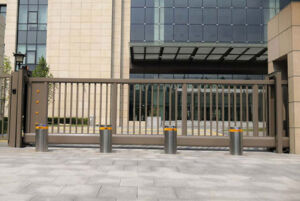Bollards are short, sturdy posts that are used to control vehicular and pedestrian traffic. They come in a variety of shapes, sizes, and materials, and can be used for a wide range of purposes, from protecting buildings and pedestrians to providing decorative accents for parks and other public spaces. In this article, we’ll provide a comprehensive guide to bollards, including their uses, materials, installation.
Uses of Bollards
Bollards can be used for a variety of purposes, depending on the specific needs of the environment in which they are installed. Some common uses for bollards include:
Traffic Control: Bollards can be used to control the flow of vehicular and pedestrian traffic, particularly in areas where there is a risk of accidents or collisions.
Security: Bollards can be used to protect buildings, infrastructure, and other high-value assets from intentional or accidental damage caused by vehicles.
Decorative: Bollards can be used to add a decorative element to public spaces, such as parks, plazas, and pedestrian areas.
Access Control: Bollards can be used to restrict access to certain areas, such as pedestrian-only zones or restricted parking areas.
Lighting: Bollards can be fitted with lights to provide illumination for pedestrians and vehicles.
Materials Used for Bollards
Bollards can be made from a variety of materials, each with its own advantages and disadvantages. Some common materials used for bollards include:
Concrete: Concrete bollards are strong and durable, making them ideal for high-traffic areas where there is a risk of accidental or intentional damage. They can also be cast in a variety of shapes and sizes, making them a popular choice for decorative bollards.
Steel: Steel bollards are also strong and durable, and can be used for both traffic control and security purposes. They are available in a variety of finishes, from painted to stainless steel, making them a popular choice for both utilitarian and decorative applications.
Plastic: Plastic bollards are lightweight and easy to install, making them a popular choice for temporary installations. They are not as durable as concrete or steel bollards, however, and may need to be replaced more frequently.
Wood: Wood bollards are a popular choice for decorative applications, such as parks and other public spaces. They are not as strong or durable as concrete or steel bollards, however, and may require more maintenance.
Here are the general steps for installing bollards:
Determine the location and purpose of the bollards: The first step is to determine where the bollards should be installed and why. This will help you choose the appropriate type and size of bollards, as well as the installation method.
Prepare the installation site: The installation site should be cleared of any debris, and the ground should be leveled and compacted. If necessary, you may need to excavate the area to create a suitable foundation.
Choose the appropriate installation method: The installation method will depend on the type of bollard you are installing, as well as the site conditions. Some common installation methods include surface mounting, core drilling, and embedded installation.
Install the bollards: Depending on the installation method, you may need to pour concrete or use anchor bolts to secure the bollards in place. Follow the manufacturer’s instructions for installation, and ensure that the bollards are level and secure.
Test the bollards: Once the bollards are installed, test them to ensure that they are functioning properly. This may include checking their stability, durability, and impact resistance.
Maintain the bollards: Bollards require regular maintenance to ensure that they remain in good condition and continue to provide the necessary protection. This may include cleaning, painting, and repairing any damage or wear and tear.
If your are interest in our products or want learn more about its specifications, material and prices, please email us directly at service@cnzasp.com. We are more than happy to answering your questions.



